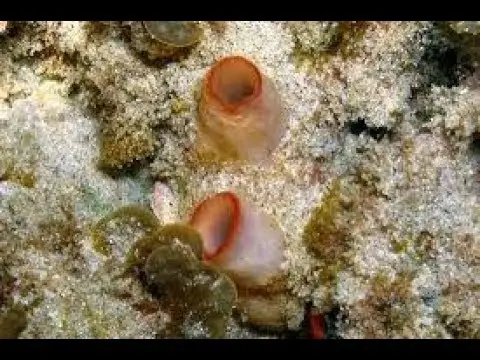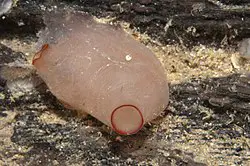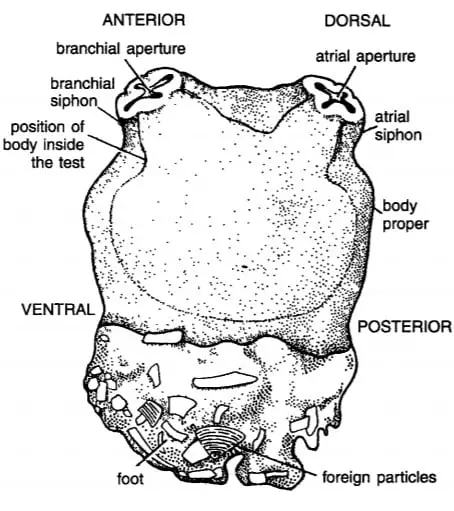Table of Contents
Excretory System of Herdmania:
In Herdmania primary excretory organ is the neural gland, it is an elliptical brownish gland present above the nerve ganglion. The neural gland is present at the mid-region between the atrial siphon and branchial siphon, this gland has several branches. Through the entire length of the gland, a longitudinal canal run,s and several peripheral tubules from the neural gland open finally into the longitudinal canal.
Excretory material in Herdmania is generally xanthine and urate particles, nephrocytes present in blood collect the excretory material from the blood and pass them into the lumen of the neural gland. From the neural gland, the excretory material goes outside of the body through the duct of a neural gland and is then discharged at the prebranchial zone.

In Herdmania neural gland perform different other important functions along with the excretory function. Neural gland control development, oviposition, metamorphosis, due to its function some workers considered neural gland similar to the pituitary gland invertebrate.
Nervous System of Herdmania:
In adult Herdmania the nervous system is very simple, the ideal brain is not present, and the nervous system is degenerate in adult Herdmania. The function of the brain is performed by a nerve ganglion known as a cerebral ganglion.
The cerebral ganglion is a solid nerve ganglion, pinkish in color, elongated, it is also known as the brain. The cerebral ganglion is present in between the atrial siphon and branchial siphon, embedded in the mantle just below the neural gland. In general cerebral ganglion is present above the neural gland but in Herdmania exceptionally it presents below the neural gland.
In cerebral ganglion bipolar and multipolar nerve cells present which take part in reflex action in their body and total three nerve fibers out from the anterior part of cerebral ganglion. Among the three nerve fibers, one supplies to the branchial siphon, and another two nerve fibers reach the atrial siphon.
Neural Complex:
The three components neural gland, cerebral ganglion, and dorsal tubercle are responsible for nervous control throughout the body, these three components are collectively known as the neural complex.

Sense Organs of Herdmania:
Difference types of sensory receptor cells are present on the whole body of Herdmania, those cells are connected to the nervous system and make the animals aware of their surroundings.
Photoreceptor:
Herdmania live in marine environments and they are able to sense the light energy and its intensity. The margin of the siphon in Herdmania has special red marginal areas, some sensory cells present along the margin of the siphon. The receptor cells have red pigments, these cells are known as ocelli which are able to sense light energy.
Tangoreceptors:
Tangoreceptors are specialized sensory cells able to sense touch stimuli which helps them to prevent attacks against different enemies. The tangoreceptors are present throughout their body, especially in the non-vascular region of the test, in vascular ampullae. These receptors are also present along the margin of the siphon and in the tentacle region.
Rheoreceptors:
Herdmania live in marine water so they must aware of the water current, the rheoreceptors are some specialized sensory cells that make them able to sense the water current. Those cells are present along the apical margin of the atrial and branchial siphon.
Thermorecptors:
They are sensory cells able to sense the temperature of the water, thermoreceptors are present in marginal areas of siphon.
Chemoreceptors:
Herdmania live in marine water and come in close contact with several chemicals present in water but some chemicals are harmful to Herdmania. So they should aware of the chemicals present in marine water, thermoreceptors help them to aware of the chemical nature of different materials present in marine water.

Tentacles:
In a branchial siphon, the tentacle is able to sense the chemical nature of food particles present in the marine water. Branchial tentacles have enough nerve supply which makes them aware of the chemical nature and size of food particles present in marine water, it perform similar functions as that of the olfactory organ in higher animals.
Dorsal Tubercle:
It is a sensory structure present in prebranchial zone of Herdmania and able to sense the taste and smell of food particles.
Reference Habitat and Habits of Herdmania
Detailed Information on
Habitat and Habits of Herdmania
External Morphology of Herdmania
Hi Everyone!!! Welcome to Imaluop. Imaluop always try to learn some new and he want to share to other people. Here we will try to learn various topics on Science, specially on Biological Sciences.